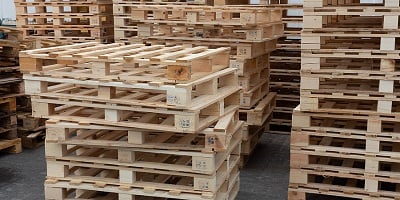Wood pallets are workhorses that constantly carry heavy loads. It’s the goal of every business that uses pallets to extend their life as much as possible, because, of course, a longer lifespan means less money spent on pallets. There are several ways to extend a pallet’s life so you can get the most out of it.
Proper Handling
A large amount of damage to pallets comes from improper handling. It’s important for your warehouse or shipping/receiving employees to be trained on handling pallets properly. Pallets are meant to be lifted when moving them – pushing or dragging them can damage the wood and loosen fasteners. Additionally, while it’s a pallet’s job to withstand weight, you should only step on the boards that are reinforced by a block or the stringer.
When moving a pallet with a forklift or pallet jack, align the fork tines slowly and carefully so that they don’t hit and damage the pallet. Additionally, always insert the forks completely into the pallet before lifting.
Proper Load Size
Pallets have a weight capacity and overloading them can cause the wood to warp or crack. To prevent damaging pallets in this way, be sure not to exceed the capacity when loading. That said, you want to ensure you’re being as efficient as possible when loading a pallet to minimize shipping costs. Maximize the available space on the pallet, ensuring there aren’t gaps between boxes or items, and load it with the heaviest items on the bottom. Strengthen and secure the pallet load by shrink wrapping it.
Pallet Storage
Proper care when storing empty pallets is as important as the care you take when handling full pallets. Pallets should be stacked flat and uniformly, no more than six feet high. This helps to ensure a stack of pallets won’t topple or fall over and get damaged. Stacking pallets flat as opposed to on their side makes it easier to access them when needed.
It’s also advisable to stack pallets on 4x4 wood off the ground to reduce the chances of rotting from moisture on the ground or floor. Rotting wood is weak and can collapse when loaded. Moisture also loosens the joints and fasteners. Finally, be sure to rotate pallet stock, using older stacks of pallets before new stacks.
Repair Instead of Replace
Broken or damaged pallets can cause safety hazards, but pallets can be repaired, saving a lot of money over buying new pallet stock. Replacing and repairing broken boards or stringers can keep your pallets in working order for years.
The right fastener is also an import part of pallet strength and lifespan. Many times, fasteners loosen and the pallet’s deckboards get separated from the stringers. This won’t happen with Crating SCRAIL® fasteners by the BECK Group. The Crating SCRAIL® is driven into the pallet boards by with a pneumatic nailing tool available through FASCO®, a member of the BECK Group. SCRAIL® fasteners have an increased holding power compared to nails, are strong and reliable, can be removed, and placement into the pallet is precise. Extend the life of your pallets with SCRAIL® Fasteners.
.svg.png)


